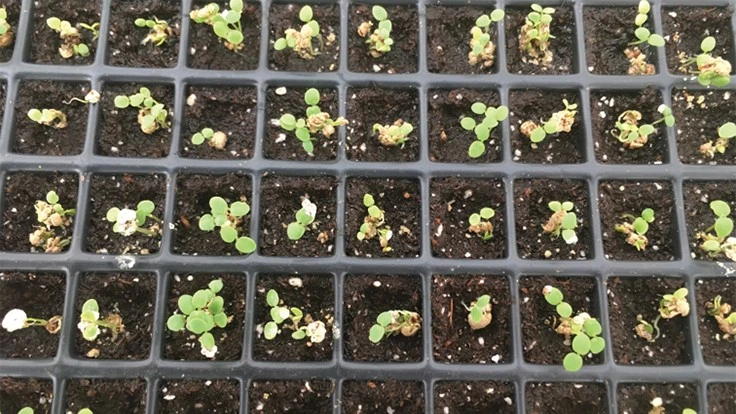

Spring is on the horizon, and greenhouses will soon be filled with annual and perennial bedding plants that are ready for retail. The first step in producing seed-propagated annuals and perennials is growing seedling plugs for transplanting into containers for finishing. Seed germination is the first step in seedling development. Germination consists of two stages: Stage 1 (radicle emergence) and Stage 2 (cotyledon expansion). In Stage 1, the seedling root or radicle emerges from the seed, while in Stage 2, cotyledons unfold and expand while the radicle penetrates the growing substrate. Once these two stages are over, germination is complete and the seedling moves into the growth stages (Stages 3 and 4, true leaf development and toning, respectively). Each stage of plug production is important and contributes to a high-quality finished plug. Germination (and the Stages comprising it) is the most crucial for growing uniform seedling plugs.
Uniform flat filling
Filling flats uniformly before seeding will improve uniformity in plug germination (Fig. 1). Cells with less substrate will dry out quicker than those with more substrate, and generally take longer to germinate due to the lower moisture around the seed. In addition to uniformly filling flats with growing substrate, ensure flats are uniformly sown or filled with seed, whether sowing by hand or using a drum seeder. While human error can cause non-uniform seeding when performing the task by hand, automated vacuum seeders can have their orifices clogged by substrate, clay seed coating and other debris, which also diminishes uniformity in plug trays.
Moisture management
Available substrate moisture is crucial to uniform seed germination. Access to water is critical for chemical and physiological processes of seed germination to occur.
However, the degree of moisture for promoting optimal germination varies among species. For instance, begonia (Begonia × semperflorens-cultorum), bedding impatiens (Impatiens walleriana), pansy (Viola × wittrockiana) and vinca (Catharanthus roseus) germinate better under “wet” conditions, whereas cosmos (Cosmos bipinnatus), dahlia, verbena (Verbena × hybrida) and zinnia (Zinnia elegans) germinate well under drier conditions. Other crops such as ageratum (Ageratum houstonianum), celosia (Celosia argentea var. plumosa), geranium (Pelargonium × hortorum) and petunia (Petunia × hybrida) germinate well under moderate moisture levels. If substrate is too dry, seeds will not germinate uniformly. Substrate moisture during germination is maintained in a variety of ways, including careful irrigation, humidity management and using a covering (Fig. 2). You should use whichever approach you are comfortable and successful with and works in your production facility. While growing too dry during germination is problematic, so is growing too wet. If the substrate is waterlogged and oxygen is unavailable to the germinating seed, radicle emergence can be inhibited and germination can be delayed.

Light
Although covering seed can aid moisture management, some seeds need covering to promote germination while others require light. Crops like begonia, impatiens and petunia require light during germination, while crops including phlox (Phlox drummodii) and vinca require covering to exclude light to improve germination. Many other species can germinate with or without light, so any covering with vermiculite or coarse perlite is more to improve moisture management for these crops.
Temperature
During germination, use temperatures warmer than those used during true leaf development (Stage 3) and toning (Stage 4). Ideal temperatures vary among species, ranging from requiring warmer (~77° F; ageratum, begonia, impatiens, vinca), moderate [72° F; cosmos, dianthus (Dianthus caryophyllus), geranium, marigold (Tagetes erecta)] or cooler (67° F; pansy, phlox) temperatures. If temperatures are too warm or too cool, germination can be delayed and uniformity can be diminished, which contributes to less-than-uniform results.
By considering all of these different factors, you should be able to improve the seed germination uniformity and get a great start on your spring crop production!

Explore the November 2019 Issue
Check out more from this issue and find your next story to read.
Latest from Greenhouse Management
- Pennsylvania Horticultural Society shares top gardening trends from 2025 Philadelphia Flower Show
- California Spring Trials 2026 dates announced
- Les Evans promoted to DRAMMwater segment manager, Al Zylstra to retire
- Hoffmann Family of Companies to acquire N.G. Heimos Greenhouses
- GIE Media Horticulture Group wins five regional 2025 Azbee Awards of Excellence
- Grant awarded to test western U.S. wood species for use as wood fiber potting substrate
- Pennsylvania Horticultural Society announces 2025 Gold Medal Plant winners
- Oasis Grower Solutions announces new Southeast territory sales manager





